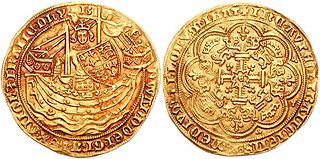
The noble was the first English gold coin produced in quantity, introduced during the second coinage (1344–1346) of King Edward III. It was preceded by the gold penny and the florin, minted during the reign of King Henry III and the beginning of the reign of King Edward III; these saw little circulation. The derivatives of the noble, the half noble and quarter noble, on the other hand, were produced in quantity and were very popular.

The history of the English penny from 1603 to 1707 covers the period of the House of Stuart, up to the Acts of Union of 1707 which brought about the Union of the Kingdom of England with the Kingdom of Scotland.

The British threepence piece, usually simply known as a threepence, thruppence, or thruppenny bit, was a denomination of sterling coinage worth 1⁄80 of one pound or 1⁄4 of one shilling. It was used in the United Kingdom, and earlier in Great Britain and England. Similar denominations were later used throughout the British Empire and Commonwealth countries, notably in Australia, New Zealand and South Africa.

The Triple Unite, valued at sixty shillings, 60/- or three pounds, was the highest English denomination to be produced in the era of the hammered coinage. It was only produced during the English Civil War, at King Charles I's mints at Oxford and, rarely, at Shrewsbury in 1642. It weighed 421 grains.
The Five Guinea was a machine-struck gold coin produced from 1668–1753. Measuring 37 millimetres in diameter and weighing between 41 and 42 grams, it was the largest regularly produced gold coin in Britain. Although the coin is commonly known as the "Five guinea" piece, during the 17th and 18th centuries it was also known as a Five-pound piece, as the guinea was originally worth twenty shillings – until its value was fixed at twenty-one shillings by a Royal Proclamation in 1717 the value fluctuated rather in the way that bullion coins do today.
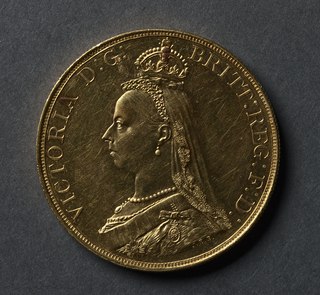
The five pound British gold coin, or quintuple sovereign, has a nominal value of five pounds sterling, and has been produced in several periods since 1820, though only struck as a circulation coin in 1887, 1893 and 1902. Through most of its history, it has depicted, on its reverse, the well-known portrayal of St George and the dragon by the Italian sculptor Benedetto Pistrucci, which has traditionally been used on the sovereign, or one-pound gold coin.

The two guinea piece was a gold coin first minted in England in 1664 with a face value of forty shillings. The source of the gold used, also provided the coin its name - the "guinea", with the regular addition of an elephant or castle symbol on the earliest issues to denote bullion supplied by the Royal African Company. For most of its period of production, the coin weighed between 16.7 and 16.8 grams and was 31-32 millimetres in diameter, although the earliest coins of Charles II were about 0.1 grams lighter and 1 millimetre smaller.

The guinea was a coin, minted in Great Britain between 1663 and 1814, that contained approximately one-quarter of an ounce of gold. The name came from the Guinea region in West Africa, from where much of the gold used to make the coins was sourced. It was the first English machine-struck gold coin, originally representing a value of 20 shillings in sterling specie, equal to one pound, but rises in the price of gold relative to silver caused the value of the guinea to increase, at times to as high as thirty shillings. From 1717 to 1816, its value was officially fixed at twenty-one shillings.

The half guinea gold coin of the Kingdom of England and later of Great Britain was first produced in 1669, some years after the Guinea entered circulation. It was officially eliminated in the Great Recoinage of 1816, although, like the guinea, it was used in quoting prices until decimalisation.
The Laurel was the third English gold coin with a value of twenty shillings or one pound produced during the reign of King James I. It was named after the laurel that the king is portrayed as wearing on his head, but it is considerably poorer in both quality and style than the sovereign and unite which preceded it. The coin was produced during James I's third coinage (1619-1625), five different busts of the king being used in these years. All the coins were produced at the Tower Mint in London. The laurel weighed 140.5 grains, less than the previous Unite but almost exactly the same as the Unite issued under Charles I.
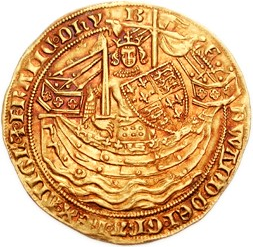
The half laurel was a coin of the Kingdom of England minted between 1619 and 1625, with a value of ten shillings.

The Rose Ryal is a gold coin of the Kingdom of England issued in the reign of King James I and is now very rare. The coin is really a two-ryal coin worth thirty shillings and is a development of the earlier fine sovereign of Queen Elizabeth I.

The unite was the second English gold coin first produced during the reign of King James I. It was named after the legends on the coin indicating the king's intention of uniting his two kingdoms of England and Scotland. The unite was valued at twenty shillings until 1612 when the increase in the value of gold throughout Europe caused it to be raised to twenty-two shillings. The coin was produced during James I's second coinage (1604–1619), and it was replaced in the third coinage by the Laurel worth twenty shillings. All the coins were produced at the Tower Mint in London.
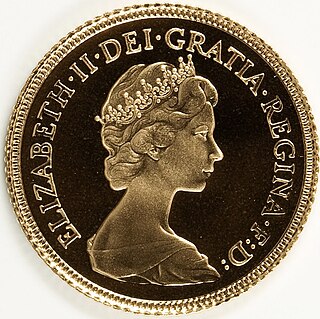
The half sovereign is a British gold coin with a nominal value of half of one pound sterling, equal to 50p, or, formerly, 10 shillings. First issued in its present form in 1817, it has been struck by the Royal Mint in most years since 1980 as a collector's and bullion piece.

The angel was an English gold coin introduced by Edward IV in 1465. It was patterned after the French angelot or ange, which had been issued since 1340. The name derived from its representation of the archangel Michael slaying a dragon. As it was considered a new issue of the noble, it was also called the angel-noble.
The threepence or threepenny bit was a denomination of currency used by various jurisdictions in England, Ireland, Scotland and Wales, valued at 1/80 of a pound or 1⁄4 of a shilling until decimalisation of the pound sterling and Irish pound in 1971. It was also used in some parts of the British Empire, notably Australia, New Zealand and South Africa.
A Crown of the Rose is an extremely rare gold coin of the Kingdom of England introduced in 1526 during the reign of Henry VIII, in an attempt to compete with the French écu au soleil. The coin was not a success and just a few months later it was replaced by the Crown of the Double-Rose.
The English shilling was a silver coin of the Kingdom of England, when first introduced known as the testoon. A shilling was worth twelve pence, and there were 20 shillings to the pound sterling. The English shilling was introduced in the 16th century and remained in circulation until it became the British shilling as the result of the Union of England and Scotland to form the Kingdom of Great Britain in 1707.

The sovereign was a gold coin of the Kingdom of England first issued in 1489 under King Henry VII. While the coin typically had a nominal value of one pound sterling and one Shilling, or twenty one shillings, the sovereign was primarily an official piece of bullion and had no mark of value on its face. Nonetheless, it was the country's first coin to be valued at one pound and one shilling
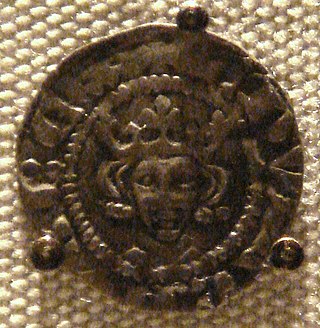
The English farthing was a coin of the Kingdom of England worth 1⁄4 of a penny, 1⁄960 of a pound sterling. Until the 13th century, farthings were pieces of pennies that had been cut into quarters to make change. The first English farthing coins were minted in the 13th century, and continued to be struck until the early 18th century, when England merged into the Kingdom of Great Britain in 1707.















